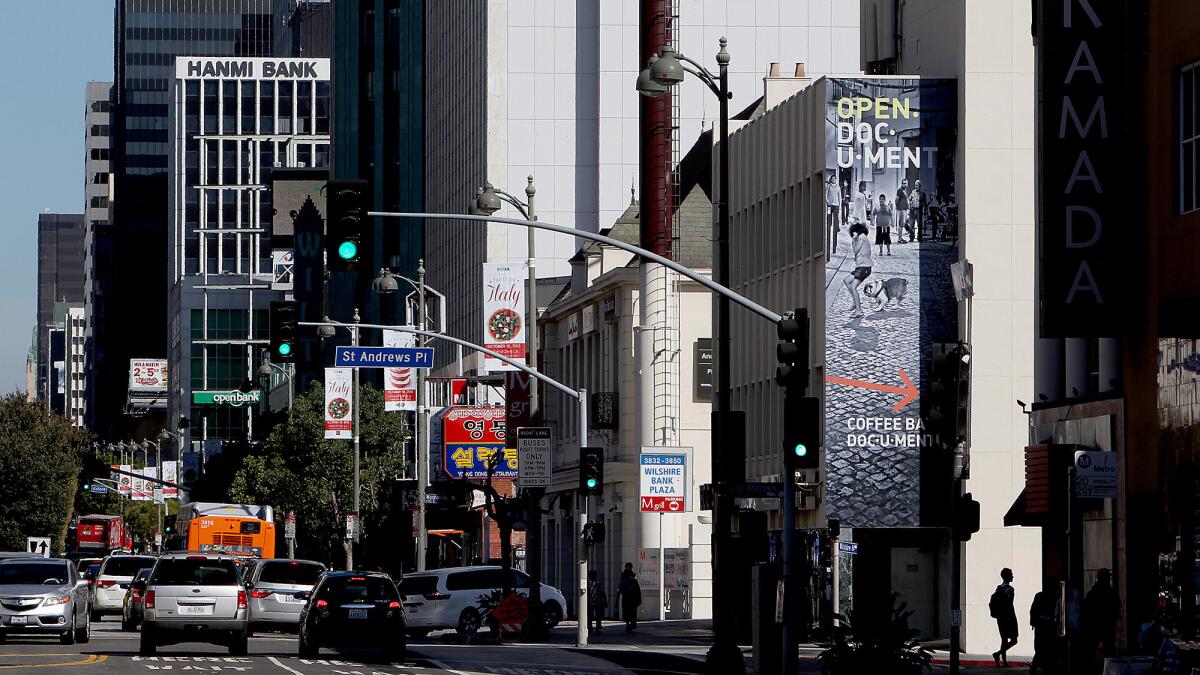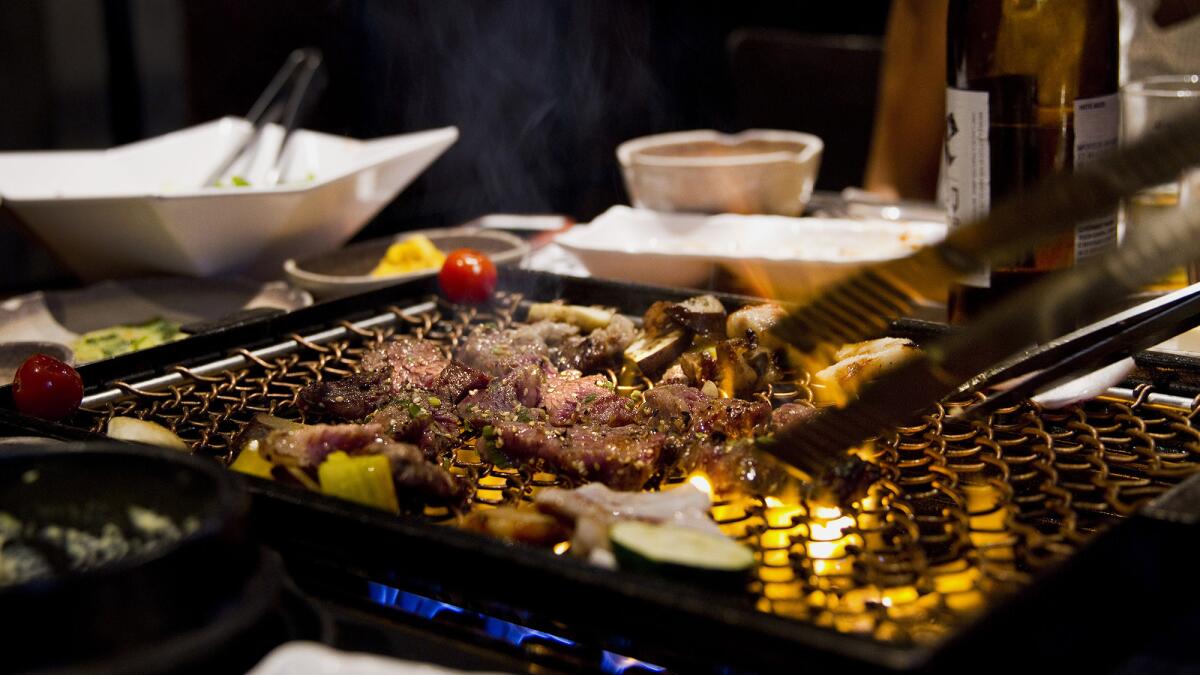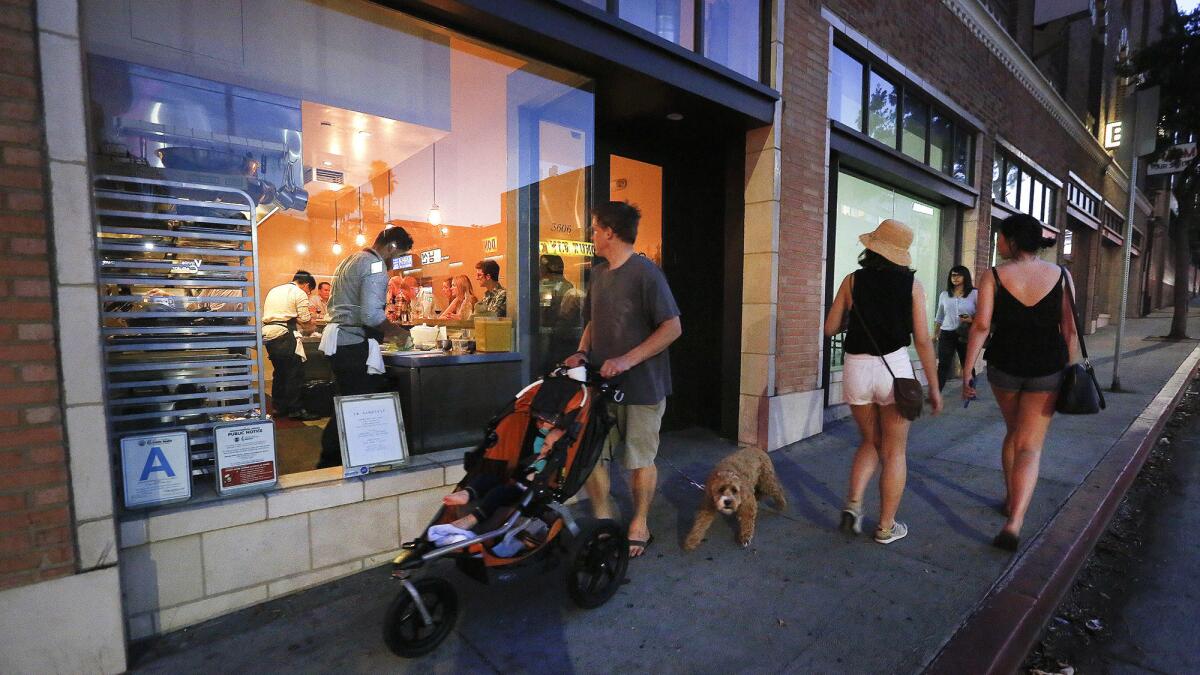Neighborhood Spotlight: Koreatown is a bustling city within a city

- Share via
Dense, diverse and undeniably L.A., Koreatown today is a dizzying hub of all-you-can-eat barbecue spots, karaoke bars, high-rise condos and 24-hour spas.
In the 1920s and 1930s, though, the neighborhood was the stomping grounds of cravat-sporting men and of women who wore their diamond rings over the fingers of their elbow-length satin gloves. These high-society folks would guzzle Champagne by the magnum and while away their days darting around town in their massive chauffeur-driven Duesenbergs.
But the area has evolved beyond its days as a simulacrum of the Upper East Side into a vibrant, polyglot neighborhood that could exist only in L.A.
It all started with Wilshire Boulevard, which was built by Henry Gaylord Wilshire in the 1890s to connect his new luxury subdivision with the city. One selling point of his development was that streetcars were forbidden on the new road.
Wealthy Angelenos flocked to the area, building grand mansions on the boulevard, which now acted as a sort of gateway drug for Westside living, dragging the city’s center of gravity out of clamorous, trolley-clogged downtown and toward a future when the city limits would end on the shores of the Pacific Ocean.
With these well-heeled residents came doorman apartments and upscale shops and restaurants, and soon the area was dubbed the “Fifth Avenue of the West.”
Glamorous destinations like the Ambassador Hotel, the Cocoanut Grove, Bullocks Wilshire and the Brown Derby lined the boulevard, and the exploding popularity of automobiles put the district within a short drive of Hollywood and Hancock Park, drawing film stars and oil tycoons alike to dine, dance and shop.
The car giveth and the car taketh away, and eventually the wealthy patrons of Wilshire Boulevard’s businesses learned that it was just as easy to drive to — and far easier to park in — neighborhoods like the Miracle Mile, the Sunset Strip and Beverly Hills. By the 1970s the department stores aside from Bullocks Wilshire were closed, the Ambassador was in decline and the Brown Derby was in its death throes.
Stunning photos, celebrity homes: Get the free weekly Hot Property newsletter »
Korean-American investors stepped in and bought struggling commercial properties, beginning a long period of recovery which, despite the body blow of the 1992 riots, has brought new apartments, hotels and monolithic shopping malls to the neighborhood. Below the street that once forbade streetcars, a subway now runs, and urban living is back in vogue.
Neighborhood highlights

Eat, drink and be merry: Whether you favor Korean barbecue with an ice-cold Hite or Oaxacan cuisine with a shot of mezcal — or both — you can find it here.
Urban living: Want street life, subways and a constantly changing neighborhood that isn’t downtown? Koreatown ticks all your boxes.
Neighborhood challenges
The bad with the good: Traffic is gnarly, the crime rate is on the high side and historic preservation requires constant vigilance (just ask the Brown Derby and Ambassador Hotel, both lost to the wrecking ball).
Parking: Good luck.
Expert insight

Real estate agent Ken Kim said Koreatown is perfect for “people who love to go out.”
“Obviously, entertainment is No. 1, and also its central location,” he said. “Transportation is really convenient.”
Several new condo developments have been built in the last few years, a plus for those who can afford them.
“Rather than buying a 5- or 10-year-old condo, they’d rather buy a new one,” he said.
Market snapshot
Portions of the 90004, 90005, 90010 and 90020 overlap the area. In May, based on 17 sales, the median price for single-family homes in the 90004 ZIP Code was $1.25 million. In the 90005 ZIP was also $1.25 million based on four sales.
In the 90010 and 90020 ZIP Codes, where multi-family buildings are prevalent, the median price for condos was $740,000 and $423,000, respectively.
Report card
More than a dozen charter and public schools lie within the boundaries of Koreatown. Among them is Charles H. Kim Elementary, which scored 886 out of a possible 1,000 in the 2013 Academic Performance Index.
Camino Nuevo Academy #2 scored 864, and Cahuenga Elementary had a score of 858. Wilshire Park Elementary scored 841; Camino Nuevo Charter Academy scored 821; and Frank del Olmo and Wilson Place elementary schools both had a score of 819.
ALSO
For LAPD cops, walking the Koreatown beat filled with mystery, confusion, cultural minefields
In a changing Boyle Heights, a tiny cantina favored by locals reopens to cheers
Neighborhood Spotlight: Mt. Washington keeps a rustic slant
Sign up for Essential California
The most important California stories and recommendations in your inbox every morning.
You may occasionally receive promotional content from the Los Angeles Times.



